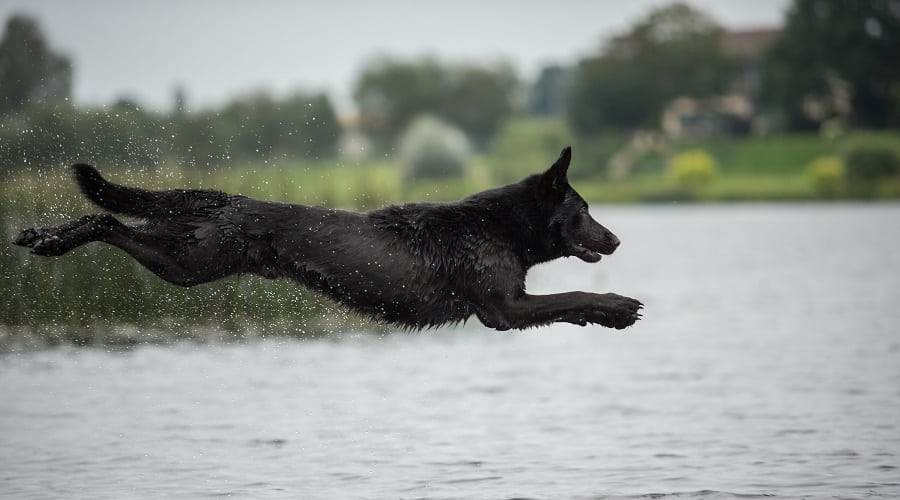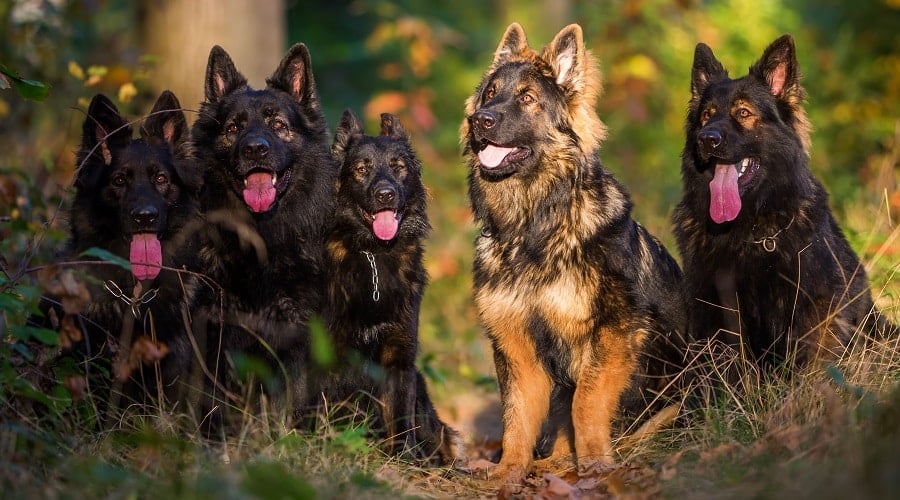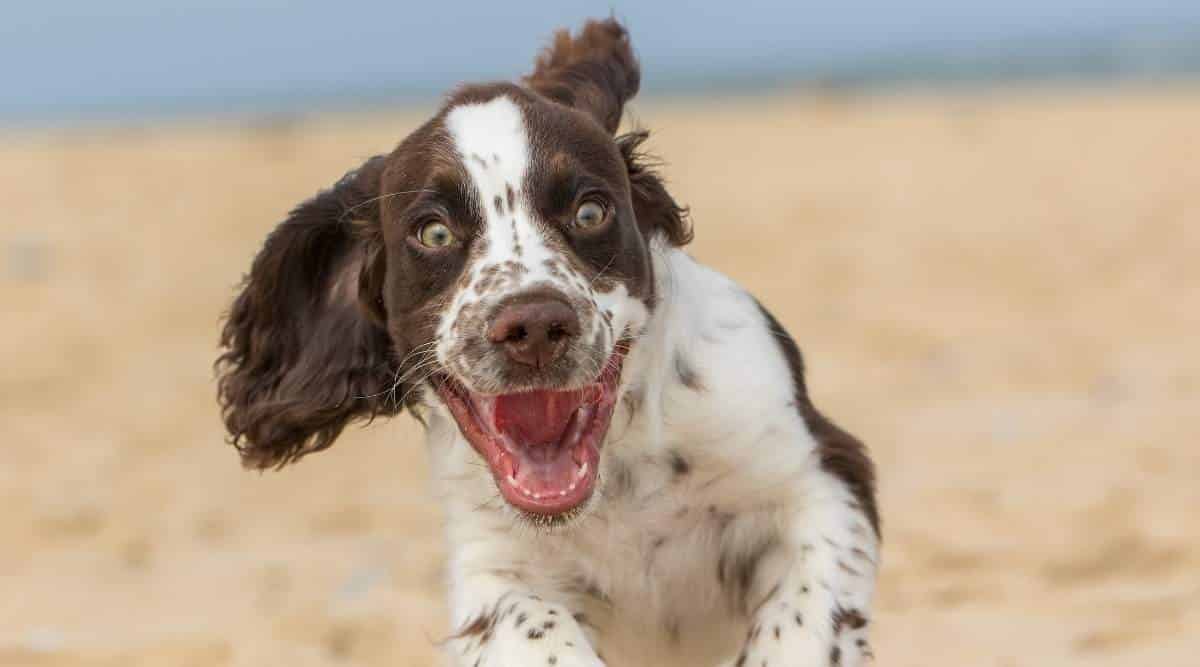Black German Shepherds: Puppies, Genetics & More
When you purchase through links on our site, we may earn a commission. Here’s how it works.
German Shepherds are one the most sought-after breeds in the world, ranking 2nd out of 194 in popularity according to the American Kennel Club. Despite its decline in the First World War due to its German association (causing the breed to be renamed “Alsatian”), these dogs are often found now in homes all over the world.
Table of Contents
Although multiple color variations exist, one of the most sought-after colorings is the black variant. Similar to long-coat GSDs, black variants are often declared as a defect; these dogs are not crossbreeds and carry the same attributes as their black and tan siblings. Because of their rarity, they are highly sought after – similar to the White German Shepherd.
Because both the black and white variations are so rare, they are seen almost as collector-type dogs, and because of that, puppy prices are higher even though they are considered a show “defect.” Let’s dive in and find out how these beautiful pups came to be and what you can expect when you are looking to add one to your family.
Black German Shepherd Overview

The black German Shepherd was a result of an accident. It isn’t known when the first black Shepherd was bred, but it was determined that the gene was considered recessive until solid black shepherds made it dominate. The gene only becomes dominant if the parent is also black.
All German Shepherds carry the black gene, but it isn’t typical for their children to stay black after 8 months. A true black Shepherd will be born black and remain black throughout their life. If you have a litter full of brown or white puppies, there’s a 0% chance of them turning black.
It’s easier to get two black German Shepherd parents to mate than to have one be black or none at all. The likelihood of getting a black Shepherd with two black parents is high. However, it is still possible to get brown or white litter even with two dominant parents. Tan parents that have the recessive gene have a chance of producing black Shepherd puppies as well, though it is small.
Build & Size

Black German Shepherds will exhibit all the same characteristics as all other German Shepherds. They are built the same and have the same genetic traits that their black and tan counterparts have as well. Below is a summary of the physical traits you can expect from your pup.
- Weight range of males is between 65-90 lbs
- Weight range of females is between 50-75 lbs
- Height range is similar between males and females, about 22-26 inches
- Pointed ears
- Long snout
- Short legs
- Long tail
- Average tendency to bark
- Average tendency to drool
- Very energetic and requires a lot of exercise
- Life expectancy 10-14 years
The only significant difference is the color of the coat. Some people will say that Black GSDs are taller or bigger, but the reality is that this varies largely by the dog, and there are larger black and tan GSDs, just like there are some larger black variants.
Coat And Color

A black German Shepherd looks very similar to an average Shepherd. They exhibit the same traditional look of the breed with few differences. They often have a straighter back and tend to be larger when compared to the standard Shepherd. Their coat can range from long to short, with their long coat giving off the appearance of feathering, flowing, or skirting.
The Black German Shepherd is solid black in color, spouting either a medium or long coat. There are variants of the black color found on Shepherds, which include black with tan, cream, silver, red, sable, and spotted.
These colors are found as solid colors (the rarest), single-color coats, or bi-colored or particolored coat which is mostly solid with marking of another color. Other colors include gray, liver, light blue, and panda.
Other Unique Shepherd Colors

Although rare, pure white, solid blue, fawn color, pure red, and spotted black and white are also found. However, neither of these colors are accepted when it comes to competitions as these colors will only be found due to severe genetic mutations or they simply don’t match the breed standards for the show. A breed’s color doesn’t necessarily come with health issues, and neither of these does.
To know if your German Shepherd is genuinely black, you need to make sure there are no patches or stripes of another color. Black Shepherds have unique features that are associated with the color, including a straighter back. You’ll notice that the average German Shepherd has a slanted back with short legs.
Although black Shepherds still have short legs, they stand taller, making them appear bigger and stronger. There are black varients with spots, creme, silver or tanned patches, or combined with a red coat, but these variants look like the average Shepherd and are hard to mix up with the black version.
Personality

Black Shepherds are widely known for their loyal, stable, and courageous personalities. They are trained to protect and make excellent guard dogs; however, they don’t deserve the negative press they’ve received. They are often non-aggressive unless trained to be this way.
If appropriately trained and socialized with children and other people outside their family, they will gladly keep a watchful eye on your baby as they’re sleeping. They see their primary job as protecting their family, so they’ll keep a careful eye on your property and notice when things are out of place.
They will need to warm up to strangers; however, if you smell like someone in the house that they’ve warmed up to they’ll be kind to you immediately. Once you’re their friend, you’re their friend forever. Being family-orientated comes with its downside, as it means they don’t like being left alone for long periods and can feel anxious or stressed. This could cause them to destroy your house or bark loudly if not trained well.
Although not suited for first-time owners (they’re too smart for their own good), black Shepherds can be the perfect family dog if appropriately socialized. Keep in mind that some Shepherd mixes might be a little more well-suited for first-time dog owners.
Grooming

If they’re medium coated, you’ll have a low-maintenance grooming schedule. If their coat is long, daily brushing will be required unless you want to risk knots and tangles. They have a double coat, which means a lot of shedding. Expect two blowouts (mass shedding) a year when spring and fall come around. Even with daily brushing, you’ll likely need to vacuum your house once a day to keep it clean.
There are steps you can take to keep hair shedding under control. If your Black German Shepherd has a longer coat, you’ll want a de-shedding tool that can help manage his undercoat. You can also use some of the many anti-shed shampoos on the market to help keep your pup’s shedding to a minimal amount.
Training & Exercise

The black German Shepherd is highly intelligent, which can make them easy to train – unless they’re not trained young enough. They thrive off of routine, positive reinforcement, and rewards. Tell them they’re good boys/girls after every trick they do. Introduce them to many things: young people, loud machines, wearing hats, other animals, and farming equipment if they’re workers.
Shepherds need to meet children at a young age to understand that they can be irritating at times. Tackle bad behavior straight away, or it will continue. When it comes to training on a leash, use a harness early if you plan to harness-train your pup. The natural instinct for many dogs is to pull, so you’ll want to stop that behavior early on. The same thing applies to crate training – make sure you have the right crate for your German shepherd before you start.
You’ll want to take your Black Shepherd out often. They are highly active dogs and require up to 60 minutes of exercise per day. They are happy to hike mountains, swim, or play ball in the yard with you. Try out multiple different things with them, as it will prevent them from getting bored.
Feeding

The bigger the dog, the more they’ll eat. Typically, owners will feed their Shepherd puppy 4 meals a day. Bigger dogs are predisposed to bloat, so it’s essential to feed them slowly as they grow bigger. Bloat could become fatal. As the black variant tends to be bigger than their regular counterparts, they will grow faster and require more food than average. Fully mature dogs usually need 1.19 grams of protein per pound of body weight and 0.59 grams of fat per pound of body weight.
- Male puppies require 2,200 to 3,000 calories
- Female puppies require 1,700 to 2,500 calories
- Male adults require 1,300 to 1,800 calories
- Female adults require 1,000 to 1,500 calories
These are just guidelines. Pay attention to your dogs’ individual needs.
Health

There are many specific issues related to the German Shepherd breed, and unfortunately, the bigger breeds, like the black variety, tend to suffer from particular health problems more than the small ones.
- Hip Dysplasia – Malformed hip joints
Elbow Dysplasia – Malformed elbow joints
Bloat or Gastric Dilatation-Volvulus – When gas builds up in the stomach from overeating
Epilepsy – Loss of control of limbs, causing violent movements
Hemophilia – Blood that can’t clot
Diabetes – From overeating, the inability to produce insulin
The above are the most common, but Shepherds can also develop cataracts, degenerative disc disease, panosteitis, allergies, pancreatitis, thyroid issues, and cancer. A lot of these issues can be bred out of your Shepherd puppy, so make sure to ask for the parents’ information before adopting if possible. Keep in mind that the vast majority of these issues happen when they’re older.
Colors For Competition

Color during competition does matter when showing off your dog. Multiple colors aren’t allowed in most competitions, including pure white, solid blue, fawn, pure red, and spotted black and white. Some colors, such as gray, liver, light blue, and panda, are deemed faulty by major kennels, but not always.
For the commonly accepted colors, pure black is included. For the dog to be considered pure black, all of their points (lips, nose, rim around the eyes, and pads) need to be black. Their eyes also need to be black, as some kennel clubs do not accept pure blacks with blue eyes. Coats lengths do not matter – all coat lengths are accepted. Black and tan, black and cream, black and silver, red and black, black and red, sable, dark sable, black sable, and bi-color/bi-black are also accepted.
In the past 100 years, many Shepherds have won top awards in multiple competitions. One of the earliest was in 1899 when Krone won the Bunderssieger Zuchtschau award. Unfortunately, it’s rare to see black Shepherds win awards in contests of any kind.
They are often overlooked at dog shows in favor of the classic breed look: black and cream. This doesn’t mean that these dogs are bad in competition; it is more likely that the association with the breed is stronger with the tan or sable color scheme. If you want a show dog, I would recommend passing up the black variant in favor of the sable.
As Family Pets

The Black Shepherd offers great companionship, security, and loyalty and gets along well with most people and animals. Provide a comfortable, supportive bed, plenty of chew toys, and a large backyard if possible. They’ll need a lot of space once they get older and desire an area that is all their own. Put their water and food bowl in a place that’s comfortable and accessible.
Having a doggy gate may be a necessity if they’re puppies as you’re attempting to socialize them. Once they’re older, they likely won’t need it. Still, with how protective the breed is, they may need to be put behind a gate if they are too energetic when they see new faces.
Black German Shepherds can be comfortable living outdoors due to their large, double coats. However, leaving them alone for long periods is bad as they’ll likely miss you. Purchase or build a dog house outside so they’ll have enough protection from the rain. Make sure it’s big enough – your black Shepherd will get quite large.
Keep your dog clean and groomed, and their fur will attract dirt and mud and may start to mat if not washed frequently. If you’re going away, it’s a good idea to have a house sitter or take them to a kennel, as they’ll require a lot of attention.
Finding A Puppy

Finding a reputable breeder is the most likely way you’ll find a black Shepherd. Finding one at a local animal shelter will save you a lot of money and potentially save a life. It isn’t difficult to see a pure black Shepherd with your eyes as technically none exist.
Since it’s a birth defect, you’ll only find this color in a litter from a black parent or a rare puppy litter from regular parents. Again, this is partly what makes the Black German Shepherd so rare. They typically only come from two parents of the same color to ensure a 100% color match, which means you are finding the rare color of the breed to mate with another rare color of the breed.
Because of this rarity, you can definitely expect the price tag of these pups to be a little higher, which we will cover in detail next.
Puppy Prices

Due to the rarity of the breed, the average cost will be a little higher. It’s difficult to determine how many puppies will be in the litter, so it may not work out even if you find a breeder that breeds the black variant. The longer-coat black Shepherds are also more expensive. Though the standard sable-colored puppies range from $900 and up, the black variant will cost you an average of $1,000 – $2,500. If you see anything outside this range, be cautious.
There are a few things to look out for when shopping for the perfect Shepherd. As mentioned, black German Shepherds are born black and stay black after 8 weeks. If the puppy is less than 8 weeks – do not purchase them. If the breeder says they know for sure that the dog’s coat won’t change color – do not buy them either. There isn’t any way of knowing until they mature past 8 weeks.
Reputable breeders will have no issue showing you the parents or papers of the parentage of the puppies you want to buy. A huge red flag is if they’re protective of this. A legitimate breeder will want you to trust them. Seeing the parentage can also determine potential health problems or the quality of the puppy.
Watch out for red flags as unscrupulous breeders will often try to pass off mixed breed puppies like a GSD/Black Labrador Retriever mix as a purebred. While we have no problem with “designer dogs,” all puppy buyers should know what they are getting.
Frequently Asked Questions
How rare are Black German Shepherds?
Black GSDs are rarer than their typical black and tan counterparts.
Are Black German Shepherds more aggressive?
Black GSDs are no more or less aggressive than the typical breed standard. How you raise them will determine how well-socialized they are.
How big do Black German Shepherds get?
They will be the same size as the breed standard. They will weigh around 55 to 100 pounds, variable based on their parents.
Do Black German Shepherds shed less?
They shed just as much as the breed standard does. Black hair will be less noticeable than the lighter-colored German Shepherds.
Is a Black German Shepherd a Purebred?
Yes, the black-coated GSD is a purebred pup. They do not suffer the same discrimination that the white-coated GSD does.
Do they have any white in their coats?
Yes, they can. But not excessive amounts. Excessive amounts may be a signal of a mixed-breed dog, so do your research.
Do they cost more than Black and Tan colored dogs?
Yes, they typically cost more because they are rarer. It will largely depend on the breeder.
Do Black German Shepherds have long hair?
Like the breed standard, they can have long hair. The hair length will vary between short, medium, and long. Long-coated black GSDs are the rarest of the color variant.
Do they have blue or amber eyes?
Black German Shepherds can have blue eyes at birth. They will develop dark orange/amber-colored eyes as they age.
Do they look like a wolf?
Some owners feel Black German Shepherds do look like a wolf. They are not closely related and are not hybrid dogs.
Final Thoughts
There is little difference between a commonly found German Shepherd and the black variety. These dogs are still large and in charge, showing off their striking coats, strong backs, and tall stature. The primary difference you can expect to deal with really comes down to the price tag because they are considered a rare coloring of the breed.
It’s interesting that what’s considered a “breeder’s defect” can end up being more expensive for the average consumer, but the market with dogs dictates what puppies will cost. We can say this with confidence, it’s a fact that the Black German Shepherd is an absolutely striking breed, and you are sure to get questions about your pup everywhere you go. Although they require a little extra care with frequent grooming and daily walks, these dogs will be your companion for life if you welcome them into your family.



